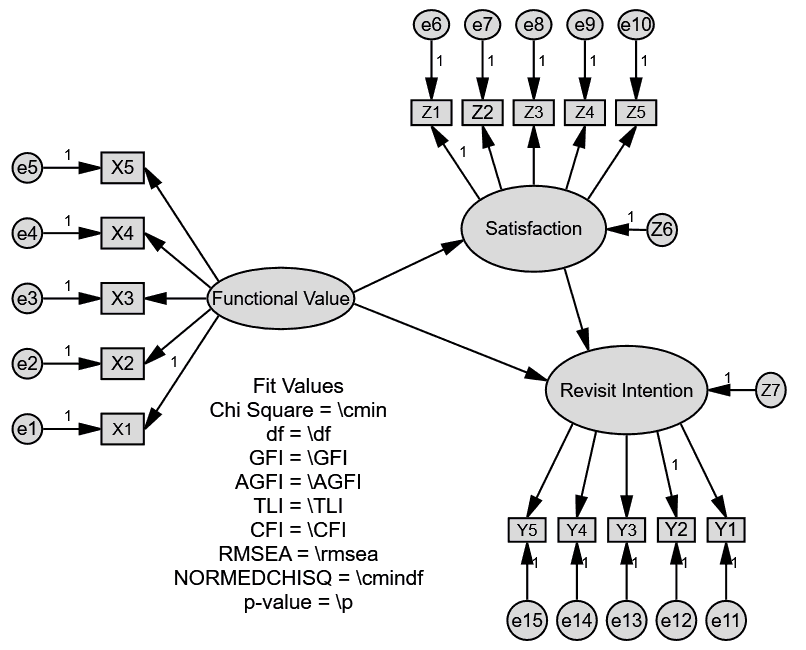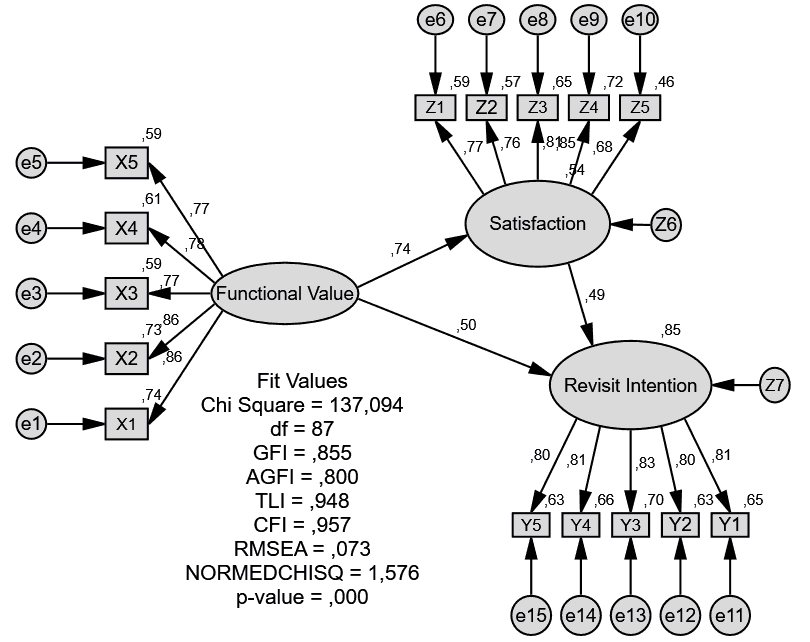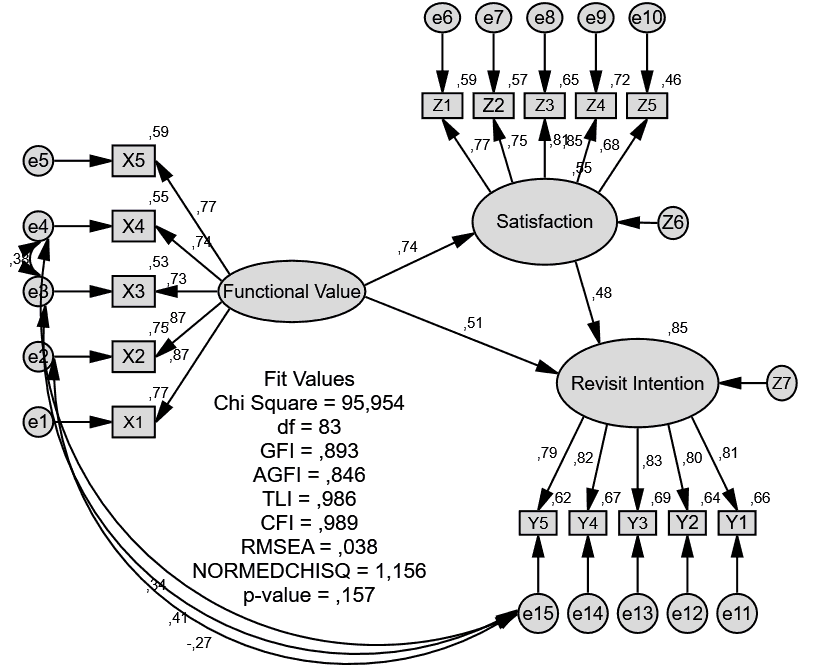Research Article: 2022 Vol: 28 Issue: 2
Functional Value of Lake Toba Super-Priority Tourists during the Covid-19 Pandemic and the Impact on Revisit Intention of Tourist
Megasari Gusandra Saragih, Universitas Pembangunan Panca Budi
Elfitra Desy Surya, Universitas Pembangunan Panca Budi
Mesra B, Universitas Pembangunan Panca Budi
Citation Information: Saragih, M.G., Surya, E.D., & Mesra, B. (2022). Functional value of lake toba super-priority tourists during the covid-19 pandemic and the impact on revisit intention of tourist. Academy of Entrepreneurship Journal, 28(S2), 1-9.
Keywords
Functional Value, Satisfaction, Revisit Intention
Abstract
This study was made to analyze the interest of returning tourists to the super-priority tourism of Lake Toba during the Covid-19 Pandemic. The main problem in this study is the decline in the number of tourist visits to Lake Toba's super-priority tourism during the COVID-19 pandemic. The analytical model used is path analysis and Sobel Test with an analytical tool. Path analysis is used to examine the extent of the influence of functional Value on tourist satisfaction and how practical Value and joy impact on the interest of visiting tourists. Meanwhile, the Sobel test was used to examine the indirect effect of functional Value on revisiting interest, mediated by tourist satisfaction. The study results found that functional Value had a significant impact on tourist satisfaction; functional value and satisfaction affected the interest of returning tourists to the super-priority tourism of Lake Toba. Satisfaction mediating partial mediation is the effect of functional Value on the welfare of returning tourists to the super-priority tourism of Lake Toba.
Introduction
Since the implementation of the physical distancing policy until the PSBB (Large-Scale Social Restrictions), which was then continued with PPKM (Enforcement of Community Activity Restrictions) where in Medan and Pematangsiantar PPKM Level 4 was extended until September 6, 2021, as an effort to prevent the spread of Covid-19 in Indonesia, all activities have become paralyzed including economic activity. One of the economic sectors that have been affected by Covid-19 is the tourism sector.
The impact of Covid-19 has also affected the success of the development of the National Tourism Strategic Area (KSPN) super-priority of Lake Toba, which is the caretaker of welcoming Lake Toba tourism worldwide. Lake Toba is an international class tourist attraction with its "super volcano geopark," which has been designated as part of the UNESCO Global Geopark (UGG). The Toba Destination Area has international standards and branding (Toba Samosir Regency Tourism Office, 2016).
During this pandemic, the number of tourist visits to North Sumatra in April 2020 declined from the previous few months. In March, arrivals amounted to 7,800 visits, 20,000 visits in February, and January 24,000 visits. The highest foreign holidays in North Sumatra came from Singapore and Malaysia, which reached 50% to 60%. This is because people from that country are still hesitant to travel, thus causing a decrease in the number of tourists from North Sumatra, especially Lake Toba (https://regional.kontan.co.id/news/kunjungan-wisatawan-di-sumut-dipredik-didominasi- tourist-local-to-year-end?page=all, 2020).
The decline in the number of tourist visits to Lake Toba certainly affects the PAD of Samosir Regency and the country's foreign exchange in general. Because the super-priority tourism sector of Lake Toba, which is expected to be the most significant contributor to the country's foreign trade, has been hampered by the Covid-19 outbreak.
Still based on data from the Central Statistics Agency that the number of foreign tourists visiting Lake Toba in the first quarter of 2021 still amounted to 85 people, down 99.27 percent from the same period in 2020 which reached 44,030 people. However, for domestic tourists has increased. This was conveyed by the Head of the Samosir Regency Office, Dumosch Pandiangan. Regarding the target for the number of tourists in 2021, Dumosch said he was optimistic that he could exceed the number of visits in 2019 and 2020. Judging from the PAD (Regional Original Income) of Samosir Regency, it had reached more than IDR 400 million at the beginning. in 2021. The Samosir Regency Tourism Office targets a total of 600,000 visits in 2021.
Seeing this fact, even though during the COVID-19 pandemic, tourist interest in visiting Lake Toba's super priority tourism partners is still very high, this must continue to be improved considering the high interest of tourists, especially domestic tourists. Therefore, the various strategies made must be focused on increasing the number of domestic tourist visits through efforts to improve the functional value of Lake Toba itself which is believed to have an impact on the satisfaction and interest of returning tourists to Lake Toba.
Theoretical Foundation
Functional Value
Functional-value is defined as "the perceived utility derived from alternative capacities for functional, usability or physical performance" (Zouganeli, 2012), it also means quality, convenience, variety, reliability, safety, accessibility, price, durability, although the main attributes have been identified as price, reliability, and durability (Tatoglu et al., 2002). The influence of accessibility on purchasing decision-making behavior is good (Cioce, 2007; Aaker, 1996). Because tourist satisfaction is linked to the quality of services supplied to them (Zouganeli, 2012; Pereira et al., 2019; Emrizal, 2016), returning tourists are more likely to return (Rajesh, 2013; Artuer, 2013). The following hypothesis is formulated:
H1: In Lake Toba's super-priority tourism, Functional Value has a substantial impact on tourist satisfaction.
H2: Functional Value has a considerable impact on returning tourists' interest in Lake Toba's super-priority tourism.
Tourist Satisfaction
Tourist satisfaction is the most important aspect in tourism business rivalry, influence on destination choice, and product and service consumption (Naidoo et al., 2010). In the tourism industry, the intention to return has long been regarded as a critical factor for business growth and survival (Pratminingsih, 2014; Ngoc & Trinh, 2015); most studies have found that destinations with a high intention to return are more likely to succeed (Pratminingsih, 2014; Ngoc & Trinh, 2015). The following hypothesis is formulated:
H3: Returning tourists' interest in Lake Toba's super-priority tourism is influenced by their level of satisfaction.
Revisit Intention
The strong desire of tourists to return to visit in the future (Sopyan, 2015) is the definition of revisit intention. Meanwhile Hellier, et al., (2003) stated that revisit intention has the same meaning as repurchase intention. Then it was said that and satisfaction had a significant effect on repeat visits (Parastiwi & Farida, 2016).
H4: Satisfaction mediates the effect of Functional Value on the interest of returning tourists to the super-priority tourism of Lake Toba
Methodology
This research approach is quantitative research with a Path Analysis model. Sources of data used in the form of primary data sources using a questionnaire. Only visitors who have visited Lake Toba can be utilized as respondents, and the sample technique was carried out utilizing a nonprobability sampling strategy with a purposive sampling approach.
The populations in this study were all tourists in Lake Toba's super-priority tourism, totaling 12,371,465 tourists (BPS Province of North Sumatra, 2019). The number of samples is determined based on the analytical tool used. According to SEM, the number of pieces can range from 5-10 of the number of indicators. Therefore, the number of samples in this study amounted to 15 x 7=105 respondents. They coupled with five respondents in case of data outliers so that the total respondents were 110 tourists on the super-priority tourism of Lake Toba.
Data collection techniques were carried out by giving a list of questions or questionnaires directly to 110 respondents who were Lake Toba tourists, which were made using a scale of 1-5 (Likert). as shows in Table 1.
| Table 1 Variable Operational Definition |
||||
|---|---|---|---|---|
| No | Variable | Operational Definition | Indicator | Scale |
| 1 | (Y) Revisit Intention |
Interest in revisiting is the behavior of tourists due to the desire to make a repeat visit to Lake Toba. |
1) Intention 2) Plan (Schedule/Booking) 3) Recommend 4) Grouping (Alliance) 5) Attachment |
Interval 1-May |
| 2 | (Z) Satisfaction |
|||
| The satisfaction of a tourist attraction is the overall result of the pleasure experienced by tourists when visiting Lake Toba. |
Waheed & Hassan (2016) 1) Island (Destination) 2) Locals 3) Guest House Services 4) Employees Performance 5) Nature |
Interval 1-May | ||
| 3 | (X) Functional Value |
Functional Value is the benefit felt by tourists when visiting Lake Toba attractions. |
Waheed & Hassan (2016) 1) Price 2) Convenience 3) Accessibility 4) Service Quality 5) Hotel Image Waheed & Hassan (201) |
Interval 1-May |
The data analysis process used in this study is SEM (Structural Equation Modeling) with AMOS (Analysis of Moment Structure) program.
The complete model with mediation in this study can be described as follows: figure 1.
The developed equation is as shown below
Z = b1X+Z6 …………………………………….. (1)
Y = b1X+b2Z+Z7 ……………………………………… (2)
Keterangan:
Y = Interested to revisit
Z = Satisfaction
X = Functional Value
b1-b2 = Estimated Coefficient
Z6-Z7 = Residual value
The indices used to test the feasibility of the model are as follows: as shows in Table 2.
| Table 2 Model Feasibility Test Index |
|
|---|---|
| Goodness Of Fit Index | Cut-off Value |
| C-square Statistics | df, a=5% |
| Probability | >0.05 |
| CMIN/DF | 2.00 |
| GFI | >0.90 |
| AGFI | >0.90 |
| TLI | >0.95 |
| CFI | >0.95 |
| RMSEA | 0.08 |
Using Ferdinand (2014) as a guide, we examine the significance level of the relationship between variables.
Analysis Results and Discussion
Analysis Results
Confirmatory Factor Analysis (CFA)
The variable pointer is said to be substantial in the event that the stacking figure esteem for each thing or marker is more noteworthy than 0.60 (Ghozali, 2013). The comes about of the CFA test for each variable can be seen in Table 3 underneath:
| Table 3 Cfa Variable Test |
||||
|---|---|---|---|---|
| Indicator | Estimate | Cut Of Value | Kesimpulan | |
| X1 | Functional Value | 0.875 | 0.60 | Valid |
| X2 | Functional Value | 0.865 | 0.60 | Valid |
| X3 | Functional Value | 0.728 | 0.60 | Valid |
| X4 | Functional Value | 0.742 | 0.60 | Valid |
| X5 | Functional Value | 0.766 | 0.60 | Valid |
| Z1 | Satisfaction | 0.771 | 0.60 | Valid |
| Z2 | Satisfaction | 0.754 | 0.60 | Valid |
| Z3 | Satisfaction | 0.809 | 0.60 | Valid |
| Z4 | Satisfaction | 0.851 | 0.60 | Valid |
| Z5 | Satisfaction | 0.676 | 0.60 | Valid |
| Y2 | RevisitIntention | ,798 | 0.60 | Valid |
| Y3 | Revisit Intention | ,832 | 0.60 | Valid |
| Y4 | Revisit Intention | ,816 | 0.60 | Valid |
| Y5 | Revisit Intention | ,790 | 0.60 | Valid |
| Y1 | Revisit Intention | ,815 | 0.60 | Valid |
Based on Table 3, it can be clarified that all markers of the information factors are substantial. It is known from the stacking calculate esteem of all hands, none of which is underneath 0.60. In case all the pointers shaping the variable build are noteworthy, they can be utilized to speak to information examination.
Normality test
as shows in Table 4.
| Table 4 Normality Test |
||||||
|---|---|---|---|---|---|---|
| Variable | min | max | skew | c.r. | kurtosis | c.r. |
| Y1 | 2.000 | 5.000 | 0.132 | 0.565 | -0.773 | -1.654 |
| Y5 | 2.000 | 5.000 | -0.049 | -0.209 | -0.497 | -1.065 |
| Y4 | 2.000 | 5.000 | -0.139 | -0.596 | -0.605 | -1.294 |
| Y3 | 2.000 | 5.000 | 0.138 | 0.589 | -0.501 | -1.072 |
| Y2 | 2.000 | 5.000 | -0.192 | -0.821 | -0.047 | -0.101 |
| Z5 | 2.000 | 5.000 | -0.402 | -1.723 | 0.261 | 0.558 |
| Z4 | 2.000 | 5.000 | -0.066 | -0.282 | -0.758 | -1.623 |
| Z3 | 2.000 | 5.000 | -0.195 | -0.833 | 0.080 | 0.172 |
| Z2 | 2.000 | 5.000 | -0.074 | -0.316 | -0.315 | -0.674 |
| Z1 | 2.000 | 5.000 | 0.037 | 0.159 | -0.314 | -0.673 |
| X5 | 2.000 | 5.000 | 0.035 | 0.148 | -0.575 | -1.230 |
| X4 | 2.000 | 5.000 | -0.169 | -0.725 | -0.096 | -0.206 |
| X3 | 2.000 | 5.000 | -0.311 | -1.334 | -0.212 | -0.454 |
| X2 | 2.000 | 5.000 | -0.196 | -0.840 | -0.468 | -1.001 |
| X1 | 2.000 | 5.000 | 0.173 | 0.739 | -0.647 | -1.385 |
From Table 3, the critical ratio skewness esteem does not have any univariate values that are exterior the esteem extend of ± 2.58. Moreover, the multivariate basic proportion esteem of kurtosis is additionally within the field of ± 2.58, which is -0.521, so it can be concluded that both univariate and multivariate information in this consider are regularly disseminated.
Model Fit Test
The complete model test was carried out in two stages: the full SEM model before the modification and the full SEM model after the conversion.
1) Full Model Test Before Modification
The full SEM model before modification is shown in Figure 2 below:
Based on Figure 1, it is known that the Goodness of Fit (GOF) does not meet the criteria, so it must be adjusted.
2) Full Model Test After Modification
The full SEM model after modification is shown in Figure 2 below:
From Figure 3 it is detailed to Table 5 the following GOF criteria:
Table
ReferencesAl-Ababneh, M., (2013). Service quality and its impact on tourist satisfaction. Interdisciplinary Journal Of Contemporary Research In Business, 4(12), 164-173. Baron, R.M., & Kenny, D.A. (1986). The moderator-mediator variable distinction in social psychological research: Conceptual, strategic, and statistical considerations.Journal of Personality and Social Psychology, 51, 1173-1182. Beerli, A., & Martin, J.D. (2004). Factors influencing destination image. Annals of Tourism Research, 31(3), 657-681. Beqiri, M., Borici, A., Boriçi, A., & Dergjini, A. (2014). An empirical study of service quality factors impacting tourist satisfaction and loyalty: Velipoja tourist destination. TMC Academic Journal, 8(2), 36-48. Chen, C.F., & Tsai, D. (2007). How destination image and evaluative factors affect behavioral intentions. Tourism Management, 28, 15-22. Dinas Pariwisata Kabupaten Toba Samosir, (2016). Ferdinand, A. (2014). Structural equation modeling in management research. Semarang: Diponegoro University Publishing Agency. Ghozali, I. (2013). Structural equation model concepts and applications with program Amos 21.0. Print V: January 2013. Diponegoro University. Semarang. Hellier, P.K., Geursen, G.M., Carr, R.A., & Rickard, J.A. (2003). Customer repurchases intention: A general structural equation model.Journal of Marketing, 37(1), 11-12. Hussain, S.A.S., (2014). Learning through examining the tourist experience. International Journal of Education and Research, 2(2), 1-21. Khan, A.H., Haque, A., & Rahman, M.S., (2013). What makes tourists satisfied? An empirical study on malaysian islamic tourist destination. Middle-East Journal of Scientific Research, 12(12),1631-1673. Mosahab, R., Mahamad, O., & Ramayah, T., (2010). Service quality, customer satisfaction, and loyalty: A test of mediation. International Business Research, 3(4),72-80. Naidoo, P. (2010). Tourist satisfaction with mauritius as a holiday destination. Global Journal of Business Research, 4(2). The University of Technology Mauritius. Ngoc, K.M., & Trinh, N.T. (2015). Factors affecting tourists’ return intention towards Vung Tau City, Vietnam-A mediation analysis of destination satisfaction. Journal of Advanced Management Science, 3(4), 292-298. Parastiwi, F., Farida, D.D., & Naili. (2016). Effect of attractiveness and word-of-mouth on revisit through satisfaction. Diponegoro University. Pratminingsih, S.A., Rudatin, C.L., & Rimenta, A.T. (2014). Roles of motivation and destination image in predicting tourist revisit intention: A Case of Bandung – Indonesia. International Journal of Innovation, Management, and Technology, 5(1),19-24. Rajesh, R., (2013). Impact of tourist perceptions, destination image and tourist satisfaction on destination loyalty: A conceptual model. Journal of tourism and cultural heritage, 11(3), 67-78. Sheth, J.N., Newman, B.I. & Gross, B.L. (1991). Why we buy what we buy: A theory of consumption values. Journal of Business Research, 22, 159-170. Sopyan. (2015). Analysis of the effect of tourist attraction and service quality on visiting interest of visitors with visitor satisfaction as an intervening variable (Study on the Lawang Sewu Building Cultural Heritage). Faculty of Economics and Business. Diponegoro University. Semarang. Sukiman, M.F. (2013). Tourist satisfaction as the key to destination survival in pahang. Science Direct, 91, 78-87. Trauer, B., & Ryan, C., (2005). Destination image, romance and place experience: an application of intimacy theory in tourism. Tourism Management, 26(4), 481-491. Waheed, N., & Hassan, Z. (2016). Influence of customer perceived value on tourist satisfaction and revisit intention: A study on guesthouses in the Maldives. International Journal of Accounting & Business Management, 4(1). Received: 25-Nov-2021, Manuscript No. AEJ-21-9968; Editor assigned: 27-Nov-2021, PreQC No. AEJ-21-9968 (PQ); Reviewed: 13-Dec-2021, QC No. AEJ-21-9968; Revised: 18-Dec-2021, Manuscript No. AEJ-21-9968 (R); Published: 03-Jan-2022. |
|---|


